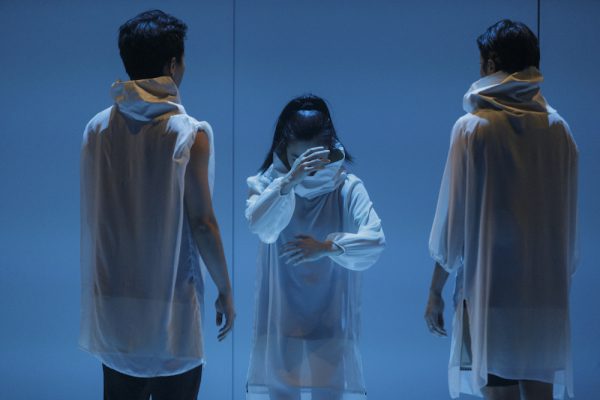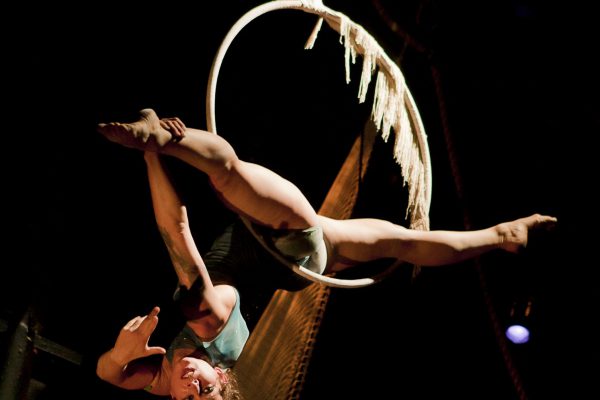Mistaken identity is the preoccupation of Nikolai Gogol’s sly play The Inspector General (in Russian, Revizor). The 1836 text, which wasn’t widely embraced at the time of its publication, makes for great farce and equally serves as a mirror for dark concerns: deceit, tyranny, greed and corruption. The co-creators of the bold and distinctive full-length Revisor, Jonathon Young (writer) and Crystal Pite (choreographer and director), bear witness to these themes in their re-telling.
Into a backwater Russian town arrives a minor civil servant incognito — the Revisor — who is mistaken for an important government inspector. Corrupt government officials have been expecting to investigate him. In this loose adaptation of the Gogol work, the breakneck script has been recorded using nine actors, with the text embodied by the virtuosic dancers who conjure the personality of each character, with the conceit being that they’re lip-synching with their whole body — dancing the text.
Pite mobilizes body expression as a speech act, as language. The dancers hit every verb and consonant with attitude. The result is of being pulled in multiple directions at once, and the poetic rat-a-tat sequencing amplifies our minds and senses (because we can feel all the exertions). But something else happens too: the gates of inspiration gently open, to paraphrase Stanislavsky.
The audience is comically drawn into the depravity, vanity, incivility, shady dealings, gamesmanship, nods and winks of political jockeying and the manic power shifts leading to overthrow. Yes, we see the frivolity, but the thrust is that we cannot divest our private lives of political meaning. From the first beat, the rumble of Owen Belton’s score suggests we are submerged in an altered universe. If the production, performed by Pite’s company Kidd Pivot, resonates with an almost ripped-from-the-headlines narrative about the grotesque tumult of the greedy and the incompetent, the work is also concerned with achieving a sense of truth. But what truth? And whose truth?
Young and Pite have collaborated before: their work Betroffenheit (2015) was a worldwide hit. In their capable hands, Revisor combines dance, acting, physical theatre, original music, recorded narration, lip-synch and rich visual design. It’s an irresistible ride. In a sense, Pite and Young are guardians of the spoken word. In their own way, they’re reviving radio drama, a nod to a celebrated part of Canadian cultural history now largely and sadly forgotten. They are ably supported by composers and sound designers Belton, Alessandro Juliani (whose father was the theatre artist and radio drama producer John Juliani) and Meg Roe. Together they’ve fashioned an electronic palette mixing recorded acoustic instruments, voices, sound effects and samples.
With a sharp eye on spectacle and culture, she has worked at the intersections of art and performance, embracing daring, wonder and compelling experimentation. Her choreography has always maintained a multiplicity of originality and stylization through works that are often dark, witty, oddball, complex and brilliantly clever. Underlying her structural concerns is a human centre, something that gives her work an enlivened, emotional and often irreverent dimension.
There’s a pleasurable embrace of the intellectual and the sensual; she delights in moving audiences with her fleshed-out strategies in pivoting and extending our perspectives. As she once indicated to me, dance “language” is “well-suited to express that which needs to be shared more viscerally.” (Full disclosure: about ten years ago, my colleague Marlene Millar and I co-directed with Pite, Lost Action: Trace, a stereoscopic short film using live action and animation.)
Revisor is physically dynamic and demands an acute alertness of the dancers, who cleverly steer us in one direction or another as the characters try to reorder the world as they know it. It’s thrilling to see how quickly the dancers process complex movement structures and ideas. We see full-bodied entanglements, with the dancers interlocking and separating, their torsos swaying, arms outstretched with a distinctive intensity. These rapturous sequences have a sculptural quality, with some very fine awareness to details such as how one dancer’s rotation of a hand, or the literal turning of a head, would change the shape of the group dynamic.
Embodying a script’s prose sets the viewer on an envious exploration of meaning amidst all the excess. Pite is working with broad, exaggerated movement that is never rough or tough. There’s something seductive about the gestures, even when the characters are being fractious. There are a few standouts. The character of the postmaster, the bearer of good news and bad, is brought to glorious life by Jermaine Spivey, who misspeaks and then, with a gesture, literally tries to stuff the words back down his throat. His embrace of this character is both hilarious and slightly frightening when he comes undone, extending the outrageousness and then pulling back to make it human. Another key player is David Raymond with his divinely comic Osip, the Revisor’s assistant-manservant, all nervous irascibility, stuttering frustration, caught illuminated in evocative glitchy lighting by Tom Visser.
The plot of the play is not the thing, and the whimsy can only go on for so long without the tone becoming predictable. At approximately the halfway point, a remix occurs. Gone are all the fine set items (scenic design by Jay Gower Taylor) — the heavy office desk, lamps, doorways, as well as the Imperial Russian military costumes (by Nancy Bryant). Instead, the section is focused on movement, with the dancers in contemporary street clothes (t-shirts, loose pants).
Small details are explored in core connections – a head on a shoulder, a pivot or a turn, or different methods of sliding along the floor. The essence of the study is in negotiating the space, sharpening images, reworking the combinations we’ve seen in the first half of the piece, striving to invent ways of reiterating, framing, fragmenting and analyzing. Dance phrasings and certain lines of recorded text from the first half get looped in a “revised” canvas. Talking out the notation of moves becomes a literal framing of what’s happening onstage. As in all of Pite’s work, gesture, posture and rhythm invoke and stoke a visceral response in the viewer. As Pite is wont to say, dance will tell the story and the dancers will be the storytellers.





